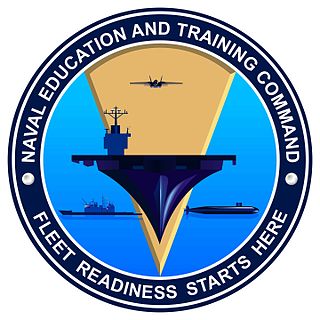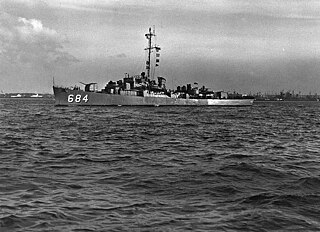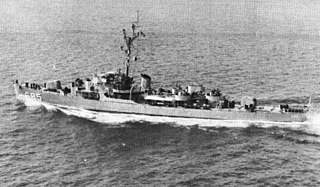Related Research Articles

Naval Submarine Base New London is the United States Navy's primary East Coast submarine base, also known as the "Home of the Submarine Force". It is located in Groton, Connecticut directly across the Thames River from its namesake city of New London.

The United States Fleet Forces Command (USFF) is a service component command of the United States Navy that provides naval forces to a wide variety of U.S. forces. The naval resources may be allocated to Combatant Commanders such as United States Northern Command (USNORTHCOM) under the authority of the Secretary of Defense. Originally formed as United States Atlantic Fleet (USLANTFLT) in 1906, it has been an integral part of the defense of the United States of America since the early 20th century. In 2002, the Fleet comprised over 118,000 Navy and Marine Corps personnel serving on 186 ships and in 1,300 aircraft, with an area of responsibility ranging over most of the Atlantic Ocean from the North Pole to the South Pole, the Caribbean Sea, Gulf of Mexico, and the waters of the Pacific Ocean along the coasts of Central and South America. The command is based at Naval Support Activity Hampton Roads in Norfolk, Virginia and is the navy's service component to U.S. Northern Command and is the Joint Functional Maritime Component Command under the U.S. Strategic Command.

USS Mackerel (SST-1), originally known as USS T-1 (SST-1), was the lead ship of the T-1-class of training submarines. She was the second submarine of the United States Navy named for the mackerel, a common food and sport fish, and was in service from 1953 to 1973. She was one of the smallest operational submarines ever built for the U.S. Navy.

USS Marlin (SST-2), originally USS T-2 (SST-2), was a T-1-class training submarine in commission from 1953 to 1973. She was the second submarine of the United States Navy to be named for the marlin, a large game fish. Except for the first 25 early development pre-WWI subs, she was one of the smallest operational submarines ever built for the U.S. Navy.

USS Tang (SS/AGSS-563), the lead ship of her class was the second ship of the United States Navy to be named for the tang.

The Naval Undersea Warfare Center (NUWC) is the United States Navy's full-spectrum research, development, test and evaluation, engineering and fleet support center for submarines, autonomous underwater systems, and offensive and defensive weapons systems associated with undersea warfare. One of the corporate laboratories of the Naval Sea Systems Command, NUWC is headquartered in Newport, Rhode Island, and has two major subordinate activities—Division Newport and Division Keyport. NUWC also controls the Fox Island Facility and Gould Island.

USS Cachalot (SC-4/SS-170), the lead ship of her class and one of the "V-boats", was the only ship of the United States Navy to be named for the sperm whale. Her keel was laid down by the Portsmouth Navy Yard. She was launched on 19 October 1933 as V-8 (SC-4) sponsored by Miss K. D. Kempff, and commissioned on 1 December 1933 with Lieutenant Commander Merril Comstock in command. Cachalot was the first submarine to have the Torpedo Data Computer, Arma Corporation's Mark 1, installed.

USS Clamagore (SS-343) is a Balao-class submarine, presently a museum ship at the Patriot's Point Naval & Maritime Museum outside Charleston, South Carolina. Built in 1945 for the United States Navy, she was still in training when World War II ended. She was named for the clamagore. A National Historic Landmark, she is the only known surviving example of a GUPPY type submarine.

Naval Air Station Jacksonville is a military airport, eight miles (13 km) south of the central business district of Jacksonville, Florida, United States. NAS Jacksonville and Naval Station Mayport are the two naval bases in Duval County.

The Naval Education and Training Command (NETC) is an enterprise level shore command of the United States Navy that is responsible for training, education and professional development of the Navy's 400,000 active duty and reserve Sailors through accession, continuing education, and advancement training. The Chief of Naval Education and Training (CNET), currently a 2-star Admiral, directs over 22,000 personnel and over 160 various activities tasked with the preponderance of training activities for USN and USMC officer and enlisted personnel. NETC itself is headquartered aboard Naval Air Station Pensacola, Florida, with NETC N7 located onboard Naval Station Norfolk.

Naval Air Station Key West, is a naval air station and military airport located on Boca Chica Key, four miles (6 km) east of the central business district of Key West, Florida, United States.

Naval Auxiliary Landing Field (NALF) San Clemente Island, also known as Frederick Sherman Field, is a military airport located on San Clemente Island, in Los Angeles County, California, USA. It has been owned by the United States Navy since 1937, but came into its current importance during the past decade. It is the Navy's only remaining live fire range. San Clemente is the southernmost Channel Island, covering 57 square miles (150 km²). The island is approximately 21 nmi (39 km) long and is 4.5 nmi (8 km) across at its widest point. It lies 55 nmi (102 km) south of Long Beach and 68 nmi (130 km) west of San Diego, California.

USS DeLong (DE-684) was a Rudderow-class destroyer escort during World War II and the Cold War.

USS Tweedy (DE-532) was a John C. Butler-class destroyer escort acquired by the U.S. Navy during World War II. The primary purpose of the destroyer escort was to escort and protect ships in convoy, in addition to other tasks as assigned, such as patrol or radar picket.

USS Brough (DE-148) was an Edsall class destroyer escort, the first United States Navy ship so named. This ship was named for Lieutenant Junior Grade David Atkins Brough, a Naval Aviator who was awarded the Air Medal posthumously for his actions during the battles of Kiska and Attu.
USS Greenwood (DE-679) was a Buckley-class destroyer escort of the United States Navy, named in honor of Lieutenant (j.g.) Frank Greenwood (1915–1942).

The United States Navy (USN) is the naval warfare service branch of the United States Armed Forces and one of the seven uniformed services of the United States. It is the largest and most capable navy in the world and it has been estimated that in terms of tonnage of its active battle fleet alone, it is larger than the next 13 navies combined, which includes 11 U.S. allies or partner nations. It has the highest combined battle fleet tonnage and the world's largest aircraft carrier fleet, with eleven in service, and two new carriers under construction. With 336,978 personnel on active duty and 101,583 in the Ready Reserve, the U.S. Navy is the third largest of the U.S. military service branches in terms of personnel. It has 290 deployable combat vessels and more than 3,700 operational aircraft as of June 2019, making it the third-largest air force in the world, after the United States Air Force and the United States Army.

USS Coates (DE-685) was a Rudderow-class destroyer escort in the United States Navy during World War II and later in the 1950s and 1960s. The ship was named for Carpenter's Mate First Class Charles Coates, who lost his life on 13 November 1942 aboard the light cruiser USS Juneau (CL-52) when it was torpedoed by the Japanese submarine I-26 during the Battle of Guadalcanal.

Naval Facility Point Sur was one of 30 top-secret sites worldwide that were built during the Cold War to detect Soviet submarines. In 1958, the U.S. Navy built a Naval Facility (NAVFAC) ½ mile south of Point Sur on the Big Sur coast to provide top-secret submarine surveillance using the classified SOSUS. The public was told the station was engaged in oceanographic research. Long-range acoustic listening was first tested and partially developed at Point Sur light station. The facility was one of the few stand-alone SOSUS stations around the world; virtually all others were part of larger bases. NAVFAC Point Sur played a key role in identifying the location of the wrecked Soviet submarine Soviet submarine K-129, a portion of which was eventually raised in a significant intelligence coup. The NAVFAC was closed in 1984, when its operations were computerized and its data transmitted to another location. All but one building was donated to California State Parks in 2000, which uses some of the buildings for housing. The facility is not open to the public.
References
- 1 2 "www.sonarshack.org". Archived from the original on 2007-06-09. Retrieved 2007-07-15.
- ↑ www.keyshistory.org